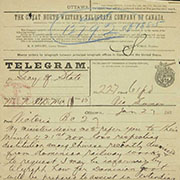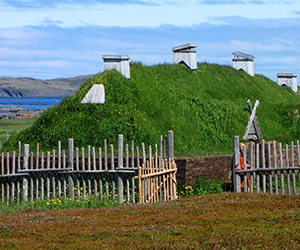CANADA HISTORY - DOCUMENTS INTERNATIONAL
1949 NATO Treaty
Analysis of the Document - (The Document follows below the Analysis)
The 1949 North Atlantic Treaty—the foundational document of NATO (North Atlantic Treaty Organization)—was a defining moment for Canada, marking its transition into a major player in global defense and collective security. Signed amidst the rising tensions of the Cold War, the treaty represented a commitment to collective defense, whereby an attack on one member would be considered an attack on all. For Canada, NATO symbolized its determination to participate actively in maintaining peace and stability in the post-World War II international order, with significant implications for its foreign policy and national identity.
Canada, having emerged from the Second World War with a strengthened international presence, saw NATO as an opportunity to ensure continued security for North America and Western Europe against the perceived threat of Soviet expansionism. Canadian leaders, particularly Prime Minister Louis St. Laurent and External Affairs Minister Lester B. Pearson, played a pivotal role in the formation of NATO, advocating for the alliance's establishment as a means of preserving peace while avoiding the isolationism that had followed the First World War. For Canada, NATO not only offered security but also reinforced its postwar commitment to multilateralism and collective diplomacy.
The treaty's implications for Canadian defense policy were profound. As a founding member of NATO, Canada committed itself to maintaining military forces ready to defend the alliance. This required the restructuring and modernization of the Canadian military, transforming it into a more professional and internationally focused force. Canadian troops were stationed in Europe as part of NATO’s collective defense strategy, including significant commitments to the defense of Western Europe during the early years of the Cold War. Canada's military presence in NATO reflected its willingness to contribute directly to global security, while also strengthening its bilateral relationship with the United States.
NATO also reinforced Canada’s sense of identity as a middle power with a unique role in global diplomacy. Canada saw itself as a bridge between the United States and Europe, advocating for cooperative approaches to security. Throughout the Cold War, Canada often acted as a mediator within NATO, supporting arms control initiatives and emphasizing the importance of diplomacy alongside military preparedness. This role became particularly evident during the debates over nuclear weapons, where Canada sought to balance its commitments to NATO with its broader goal of reducing the risks of global conflict.
Domestically, NATO membership had lasting implications for Canadian society and politics. The Canadian public generally supported the alliance, viewing it as a necessary response to the geopolitical challenges of the time. However, NATO also sparked debates over Canada’s military spending, sovereignty, and the extent of its alignment with U.S. foreign policy. As the Cold War intensified, Canada faced the challenge of balancing its NATO commitments with its independent foreign policy goals, particularly as it sought to carve out a distinct role as a peacekeeping nation.
NATO’s influence on Canada extended beyond military and defense matters. It helped shape the country’s role in international institutions, contributing to its leadership in organizations like the United Nations, where Canada became known for its efforts in peacekeeping, diplomacy, and human rights advocacy. NATO also deepened Canada’s economic and political ties with Western Europe and the United States, reinforcing its place within the broader Western alliance during a period of global polarization.
In conclusion, the 1949 NATO Treaty was a turning point in Canadian history. It symbolized Canada’s commitment to collective security and its emergence as a key player in the global effort to maintain peace and stability during the Cold War. Through its involvement in NATO, Canada strengthened its international presence, contributed to the defense of Europe, and cemented its identity as a nation dedicated to multilateralism, diplomacy, and international cooperation. NATO continues to be a central pillar of Canada’s defense and foreign policy, reflecting the enduring legacy of the 1949 treaty.

The North Atlantic Treaty
Washington DC, 4th April 1949
The Parties to this Treaty reaffirm their faith in the purposes and principles of the Charter of the United Nations and their desire to live in peace with all peoples and all governments.
They are determined to safeguard the freedom, common heritage and civilisation of their peoples, founded on the principles of democracy, individual liberty and the rule of law.
They seek to promote stability and well-being in the North Atlantic area.
They are resolved to unite their efforts for collective defence and for the preservation of peace and security.
They therefore agree to this North Atlantic Treaty:
ARTICLE 1
The Parties undertake, as set forth in the Charter of the United Nations, to settle any international dispute in which they may be involved by peaceful means in such a manner that international peace and security and justice are not endangered, and to refrain in their international relations from the threat or use of force in any manner inconsistent with the purposes of the United Nations.
ARTICLE 2
Parties will contribute toward the further development of peaceful and friendly international relations by strengthening their free institutions, by bringing about a better understanding of the principles upon which these institutions are founded, and by promoting conditions of stability and well-being. They will seek to eliminate conflict in their international economic policies and will encourage economic collaboration between any or all of them.
ARTICLE 3
In order more effectively to achieve the objectives of this Treaty, theParties, separately and jointly, by means of continuous and effective self-help and mutual aid, will maintain and develop their individual and collective capacity to resist armed attack.
ARTICLE 4
The Parties will consult together whenever, in the opinion of any of them, the territorial integrity, political independence or security of any of the Parties is threatened.
ARTICLE 5
The Parties agree that an armed attack against one or more of them in Europe or North America shall be considered an attack against them all, and consequently they agree that, if such an armed attack occurs, each of them, in exercise of the right of individual or collective selfdefence recognised by Article 51 of the Charter of the United Nations, will assist the Party or Parties so attacked by taking forthwith, individually, and in concert with the other Parties, such action as it deems necessary, including the use of armed force, to restore and maintain the security of the North Atlantic area.
Any such armed attack and all measures taken as a result thereof shall immediately be reported to the Security Council. Such measures shall be terminated when the Security Council has taken the measures necessary to restore and maintain international peace and security.
ARTICLE 6
For the purpose of Article 5, an armed attack on one or more of the Parties is deemed to include an armed attack:
- (1) on the territory of any of the Parties in Europe or North America, on the Algerian Departments of France (2), on the territory of Turkey or on the islands under the jurisdiction of any of the Parties in the North Atlantic area north of the Tropic of Cancer;
- on the forces, vessels, or aircraft of any of the Parties, when in or over these territories or any area in Europe in which occupation forces of any of the Parties were stationed on the date when the Treaty entered into force or the Mediterranean Sea or the North Atlantic area north of the Tropic of Cancer.
ARTICLE 7
The Treaty does not effect, and shall not be interpreted as affecting, in any way the rights and obligations under the Charter of the Parties which are members of the United Nations, or the primary responsibility of the Security Council for the maintenance of international peace and security.
1 As amended by Article 2 of the Protocol to the North Atlantic Treaty on the accesion of Greece and Turkey.
2 On 16th January 1963 the Council noted that insofar as the former Algerian Departments of France were concerned the relevant clauses of this Treaty had become inapplicable as from 3rd July 1962.
ARTICLE 8
Each Party declares that none of the international engagements now in force between it and any other of the Parties or any third State is in conflict with the provisions of this Treaty, and undertakes not to enter into any international engagement in conflict with this Treaty.
ARTICLE 9
The Parties hereby establish a Council, on which each of them shall be represented to consider matters concerning the implementation of this Treaty. The Council shall be so organised as to be able to meet promptly at any time. The Council shall set up such subsidiary bodies as may be necessary; in particular it shall establish immediately a defence committee which shall recommend measures for the implementation of Articles 3 and 5.
ARTICLE 10
The Parties may, by unanimous agreement, invite any other European State in a position to further the principles of this Treaty and to contribute to the security of the North Atlantic area to accede to this Treaty. Any State so invited may become a party to the Treaty by depositing its instrument of accession with the Government of the United States of America. The Government of the United States of America will inform each of the Parties of the deposit of each such instrument of accession.
ARTICLE 11
This Treaty shall be ratified and its provisions carried out by the Parties in accordance with their respective constitutional processes. The instruments of ratification shall be deposited as soon as possible with the Government of the United States of America, which will notify all the other signatories of each deposit. The Treaty shall enter into force between the States which have ratified it as soon as the ratification of the majority of the signatories, including the ratifications of Belgium, Canada, France, Luxembourg, the Netherlands, the United Kingdom and the United States, have been deposited and shall come into effect with respect to other States on the date of the deposit of their ratifications.3
ARTICLE 12
After the Treaty has been in force for ten years, or at any time 3 The Treaty came into force on 24 August 1949, after the deposition of the ratifications of all signatory states.
Thereafter, the Parties shall, if any of them so requests, consult together for the purpose of reviewing the Treaty, having regard for the factors then affecting peace and security in the North Atlantic area including the development of universal as well as regional arrangements under the Charter of the United Nations for the maintenance of international peace and security.
ARTICLE 13
After the Treaty has been in force for twenty years, any Party may cease to be a Party one year after its notice of denunciation has been given to the Government of the United States of America, which will inform the Governments of the other Parties of the deposit of each notice of denunciation.
ARTICLE 14
This Treaty, of which the English and French texts are equally authentic, shall be deposited in the archives of the Government of the United States of America. Duly certified copies will be transmitted by that government to the governments of the other signatories.
Cite Article : www.canadahistory.com/sections/documents
Source:



